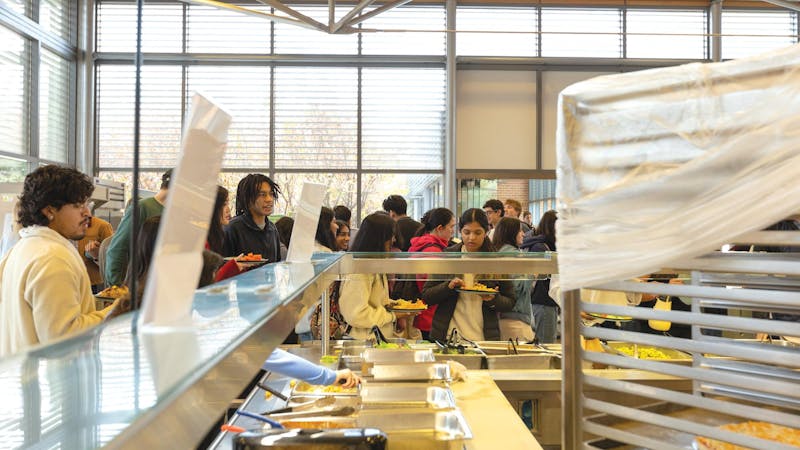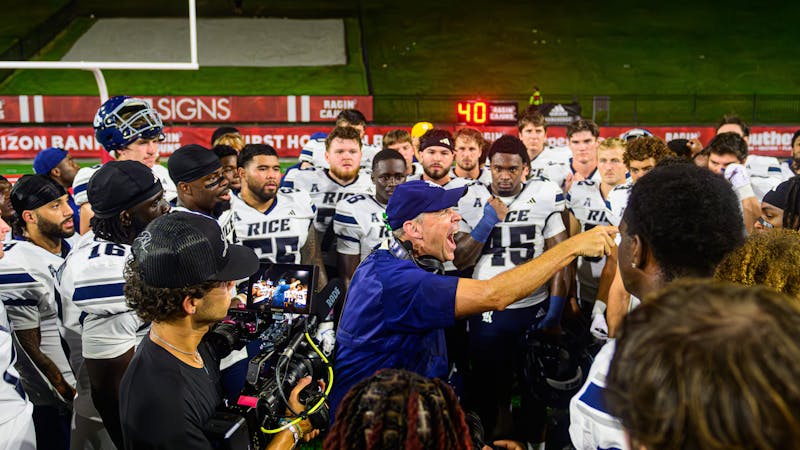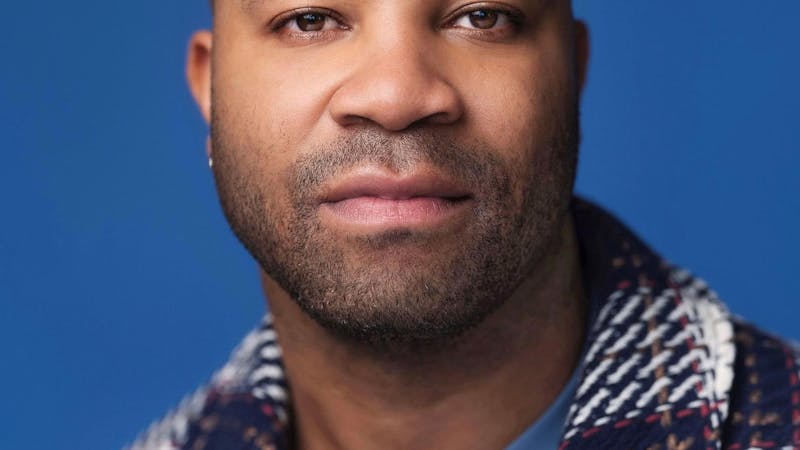Willy revolutionaries return to Rice for 20th anniversary of prank
The April 12, 1988 turning of Willy's statue has become the stuff of Rice legend, and every good campus tour guide will mention the famous prank when showing prospective students through the academic quad. Like every legend, however, the specifics remained unclear, and the questions of who was behind the prank and how they did it remained unanswered. But last Friday, on the 20th anniversary of the prank, a group of 11 Rice alumni involved in the turning of Willy's statue returned to campus for the screening of the new documentary 180 -- The Spin on Willy's Statue, ready to explain everything and to unveil their plans for a $180,000 engineering fund.The FOX 6 news reporter who was assigned to cover the story had also attended Rice when the prank occurred and, in a recurring pattern, Houston Chronicle reporter Lisa Gray (Brown '88) was also at Rice at the time, and had covered the story for the Thresher.
The group which assembled at Willy's statue included Terry Joseph Brudner (Wiess '88), Chris Cannon (Wiess '88), Patrick Dyson (Wiess '88), Greg Heath (Wiess '88), Alex Kazim (Wiess '88), Brian Sweeney (Wiess '88), Chris Ryan (Wiess '88) and John Q. Smith (Wiess '86). Theresa Bujnoch (Wiess '88), who married Cannon, made the documentary and interviewed eight of the 11 members of the group.
An earlier model
While the successful turning of Willy's statue may make the cut for campus tours, the group had gotten the idea from an earlier attempt in 1986.
Smith said he thought of the prank while at pub during his senior year. He said he wanted to pull a university-wide prank rather than one between colleges and he first considered the 45-90-180 statues in the physics quad.
"They had all arrived while we were at school, and all of us thought they were pretty damn silly," Smith said.
He said he wanted to turn Willy's statue for graduation.
Smith said the group struggled with lifting the statue, and eventually had to abandon the idea. Willy's statue does not have a uniformly distributed weight, which means it will lean to one side when lifted. Smith said the group did not take this into consideration and had to immediately replace the statue after lifting it off the pedestal.
Kazim said this attempt helped the 1988 jack since the so-called mastermind of the event had been part of the 1986 group and used that knowledge to fuel the successful rotation.
The so-called leader of the group did not attend the documentary screening.
"He thinks talking about it cancels out the mystique of [the jack] and diminishes it," Smith said.
He said the group had attempted to get the mastermind involved, to no avail.
Planning the rotation
Kazim said the group needed access to Anderson Hall to install lookouts while group members turned the statue. He said the group replaced the padlock to the front doors of Anderson Hall with another padlock, and group members had a duplicate key to the lock.
Kazim said group members also dismantled a halogen light bulb from a light that directly shone on the statue every day for two weeks. In the morning, the group would replace the lightbulb so staff would ignore the work order. He said the staff eventually got used to the light being out at night and working during the day. This allowed the group to work in the dark while rotating the statue.
"We didn't want to alert suspicion," Kazim said.
Kazim said the group had tracked RUPD's night schedule so they knew when to expect the circling cars. Other members of the group stood as lookout on the inner loop.
The group's leader designed a computer program to calculate its weight distribution and the type of A-frame they would need to hoist the statue from its pedestal, and the group used this data.
Around 6 a.m. on April 12, 1988, the group finished rotating the statue.
Kazim said it was light by this time and staff members and joggers had gathered around to watch.
Dyson said the group's leader was in the academic quad when he overheard then-President George Rupp talking about the statue.
"He heard Rupp say, 'Get the statue turned around before the media gets wind of this,'" Dyson said. "And that's when he thought, 'We need to alert the media!'"
Dyson said local news teams covered the event during the six hours the statue remained facing Fondren Library. He said by noon the university had hired art movers to return the statue to its original position.
Dyson said the group alerted the Thresher after their prank. By the time the statue was moved back, local news teams, the Washington Post, the New York Times and international newspapers had covered the story. Dyson said the press coverage was overwhelmingly positive.
"My grandmother called me from Australia, where she had read about it in Stars and Stripes," Dyson said.
The aftermath
Dyson was the only member of the group to be apprehended. While driving the pick-up truck with the A-frames and hardware the group used to rotate the statue, Dyson was stopped by RUPD.
"I told them I had been involved in a prank, but that it had gone wrong," Dyson said.
RUPD fined Dyson $2,500 for turning Willy's statue. He said he did not give up any names, though this might have meant a cheaper fine.
Dyson said his father, then-Chemical Engineering Professor Derek Dyson, was understanding. Dyson said he arrived at his parents' house the morning of the prank and asked them to guess what he had done.
"I think my father's first guess was something like, 'Did you win the Nobel Peace Prize?' or something like that," Dyson said. "But his next guess was that I had turned Willy's statue."
Dyson paid off his fine by making commemorative t-shirts of the Willy's statue blueprints. He said the shirts sold quickly.
Smith said rumors had circulated about the prank being political since it faced the statue away from Lovett Hall, where much of the Rice administrative offices are located. He said the prank was never intended to be a political statement and was meant as a senior prank.
Dyson said the statue was slightly damaged while it was being moved, though it is not clear whether the group of students or the hired contractors is at fault.
The scholarship
After the screening of the documentary, William Pettus Hobby Professor of History John Boles (Will Rice '65) spoke to the panelists about their Willy Revolution Engineering Undergraduate Innovation and Excellence Fund at Rice, which the group members started this year with a $138,000 contribution to the George R. Brown School of Engineering. This fund will provide scholarships for engineering students. Kazim said the group plans to award scholarships starting this year.
On the subject of large-scale pranks, Smith said he wanted Rice students to surpass the Willy's statue prank.
"Where are the others?" Smith said. "The one thing I've been really disappointed about over the years is, there have not been university-level pranks that will be remembered nationally.
More from The Rice Thresher

Over 1,000 students petition against new meal plan
When Konstantin Savvon opened the Housing and Dining email announcing the new unlimited meal plan, he was instantly concerned about the impact on off-campus students like himself.

Rice football wins season opener under new coach
For the first time since 2018, Rice football opened its season with a victory. Scott Abell was soaked with yellow Powerade following a 14-12 win on the road Saturday against the University of Louisiana at Lafayette, which won 10 games and made it to the Sun Belt Conference championship last season.

Acting like an athlete: Rice basketball alum takes on Broadway
Underneath Chadd Alexander’s Broadway costume, there’s ankle tape and wrist braces — same protective gear he wore as a walk-on basketball player at Rice, though now he’s performing eight shows a week in the ensemble of “Harry Potter and the Cursed Child” instead of running conditioning drills in Tudor Fieldhouse.

Please note All comments are eligible for publication by The Rice Thresher.